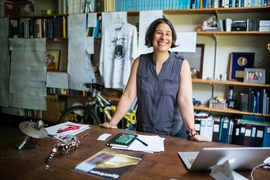Anette “Peko” Hosoi has been named associate dean of MIT’s School of Engineering. Currently the associate department head in the Department of Mechanical Engineering and the Neil and Jane Pappalardo Professor of Mechanical Engineering, Hosoi has been at MIT since 1997 and a member of the faculty since 2002. She will begin her new role on Sept. 1, 2017. Vladimir Bulović, the Fariborz Maseeh (1990) Professor of Emerging Technology, serves as the school’s associate dean for innovation in the School of Engineering.
“I am thrilled that Peko has agreed to join the dean’s leadership team,”says Anantha Chandrakasan, dean of the School of Engineering. “She is a distinguished scholar and a real force in helping us understand how we can better educate our students. I am looking forward to working closely with her as our plans in the school begin to take shape.”
Hosoi will contribute to the school’s mission broadly, though she anticipates making the most contributions in educational initiatives and strategic planning and implementation.
From her first job at MIT as an instructor in the Department of Mathematics, to her role as one of the faculty leaders for the New Engineering Education Transformation (NEET) program, Hosoi has a long record of working closely with students. A MacVicar Faculty Fellow, she has been instrumental in creating and supporting a range of educational activities in mechanical engineering, including enhancements to the current flexible undergraduate program Course 2-A and student activities such as MakerWorks. She is also a past winner of the Ruth and Joel Spira Award for Distinguished Teaching, the School of Engineering Junior Bose Award for Education, the Bose Award for Excellence in Teaching, and the Den Hartog Distinguished Educator Award. Hosoi believes the School of Engineering is poised to make some significant changes in how the Institute trains its engineers.
“We as MIT faculty are extremely precise and analytical in our research,” she notes. “We need to bring the same rigor to how we think about education.” NEET, which Hosoi co-leads with Ford Professor of Engineering Edward Crawley, stems from exactly this kind of thinking, Hosoi adds.
Hosoi, who studied physics at Princeton University and then the University of Chicago, began her research career working in fluid mechanics and thin-film flows. Over the years, she says, her work has followed a circuitous path through soft matter, soft robotics, bio-inspired engineering design, biomechanics, and sports technology. Her research has garnered attention by both fellow scientists and the general media. Recent discoveries of note include a beaver-inspired wetsuit that maximizes warmth and minimizes bulk, a “tree-on-a-chip” design that mimics the pumping mechanism of trees and plants, and even a digging robot inspired by the Atlantic razor clam. In 2012, Hosoi was named a fellow of the American Physical Society for “innovative work in thin fluid films and in the study of nonlinear interactions between viscous fluids and deformable interfaces including shape, kinematic, and rheological optimization in biological systems.”
Hosoi’s interest in sports led her to co-found MIT 3-Sigma Sports, a program that seeks to improve athletic performance and advance endurance, speed, accuracy, and agility in sports through collaborations between students, faculty, alumni, and industry partners. This combination of people around a particular problem is exactly what Hosoi wants to do more of, she says. “The most successful research programs at MIT always engage the students in some way.”
Hosoi’s nickname comes from a brand of Japanese candy: “It’s like an American being called ‘Snickers’” she says. “My grandmother, who’s Japanese, thought I looked like the little girl on the box, and it stuck.” She lives in Cambridge, Massachusetts, with her husband Justin Brooke.












